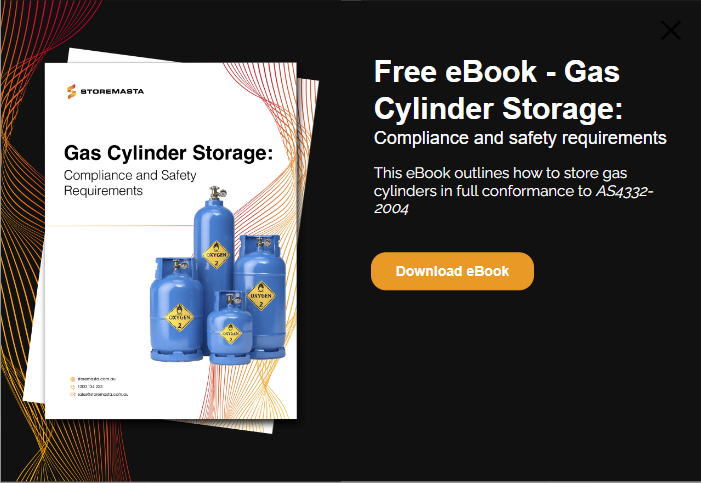All workplaces that keep compressed gases in cylinders require placards and signs that meet the requirements of the WHS Regulation in their applicable state or territory, plus relevant standards like AS 1319 Safety Signs for the Occupational Environment. Penalties of up to $30,000 can be enforced for not having correct signs in place at your chemical and cylinder stores. This blog looks at the required signage: what you need, and where to put it.
Outdoor Warning Placards
Placards are a visual warning of the hazards associated with the gas cylinders and other Dangerous Goods kept at your premises. When a workplace exceeds ‘placarding quantities’ identified in the WHS Regulation current in your state or territory, outdoor warning placards relating to each hazard class must be display. Threshold quantities for gas cylinders include:
- 200 litres of Class 2.1 Flammable Gases
- 50 litres of Class 2.3 Toxic Gases and Corrosive Gases
- 5,000 litres of aerosols
- 1,000 litres of other gases
Calculations should be based on the maximum capacity of the cylinder and empty cylinders need to also be included.
REMEMBER: There are threshold limits for all hazard classes, and this article is general guide and relates only to gas cylinders. Always refer to AS4332-2004 - The storage and handling of gases in cylinders as well as NOHSC:2017(2001) Storage and Handling of Workplace Dangerous Goods.
If the threshold limits are exceeded, outer warning placards will be required at all entrances that emergency services use to access the worksite. These will include the main entrance, back and side-street entrances, as well as entrances from neighbouring properties. There are provisions in the Standard for variations to this requirement (eg, at very large premises like a port facility, rail yard or manufacturing plant); so you should consult with your emergency services provider to discuss this further.
TIP: Why not get in touch with one of our expert Field Consultants here at STOREMASTA. We combine our technical knowledge and onsite experience to help you manage the risks and hazards associated with the Dangerous goods used and stored at your workplace.
Placards at Cylinder Stores
Australian Standard AS4332-2004 requires that two additional placards are placed on the cylinder stores: a warning sign to ban smoking and ignition sources, and a warning sign to restrict entry. These signs should display the words:
- DANGER: NO SMOKING, NO IGNITION SOURCES.
- RESTRICTED AREA, AUTHORISED PERSONNEL ONLY
The warning signs need to meet the requirements of AS 1319 Safety Signs for the Occupational Environment eg, letter height at least 50mm and a contrasting background.
Understanding Warning Placards
Warning placards display one of four different elements: pictograms, signal words, hazard statements, and precautionary statements. These are outlined below:
- Pictograms - represent the hazard class using easily recognised symbols and colours. eg, red background + flames (flammables), skull and crossbones (toxic substances), blue background (dangerous when wet).
- Signal Words - are used to indicate the relative severity of the hazard eg, ‘DANGER’ or ‘WARNING’.
- Hazard Statements - summarise the nature of the hazard and the severity of the consequences eg, May cause or intensify fire, Extremely flammable gas, Contains refrigerated gas; May cause cryogenic burns or injury
- Precautionary Statements - are brief recommendations for safe handling and storage, or what to do in an emergency eg, Wear respiratory protection; Protect from sunlight. Store in a well ventilated place; Use only non-sparking tools.
NOTE: Hazard and Precautionary statements are also specified on the Safety Data Sheets (SDSs) that accompany all Hazardous Chemicals including compressed gases.
Installing Placards
Warning placards may not moved around: they must be permanently fixed so that any person entering an area that contains Dangerous Goods will quickly be alerted to the hazards. The WHS Regulation in each state/territory requires that:
- Placards are mounted at eye level
- There is enough natural or artificial light for people to read the signs
- Signs are not obstructed by moveable objects like an open window or door, racks or trolleys
- Additional signs are not installed close by which could confuse the message or distract employees from the hazard
- Warning placards are kept clean and well maintained
- Placards are replaced promptly if changes are made to operating procedures or labeling guidelines
Not having the correct signage and warning placards in place can be disastrous to a business. Personnel entering an area — unaware of cylinder hazards like extremely flammable gases — could unwittingly cause a fire or explosion from static electricity generated by personal electronics or even their clothing. It’s essential that you read the legislation carefully, calculate the quantities of all Dangerous Goods kept on your premises, and make sure you have the correct signs and placards installed in the right areas.
Next Steps
Having correct signage at your worksite is only one part of controlling the risks associated with gases stored in cylinders. To learn more about risk control measures for gas cylinders why not download our free eBook Gas Cylinder Storage: Compliance and safety requirements. You’ll learn exactly how to get started in safely managing the compressed gases stored at you worksite.

Joining the team as a Dangerous Goods Storage Consultant, Melissa Hampton became Storemasta's Marketing Manager in late 2021. With extensive knowledge and experience in chemical compliance, Melissa is responsible for leading the Marketing team and helping shape their marketing strategy. In her spare time, you can find Melissa hiking, swimming and enjoying the great outdoors in beautiful north-west Tasmania.